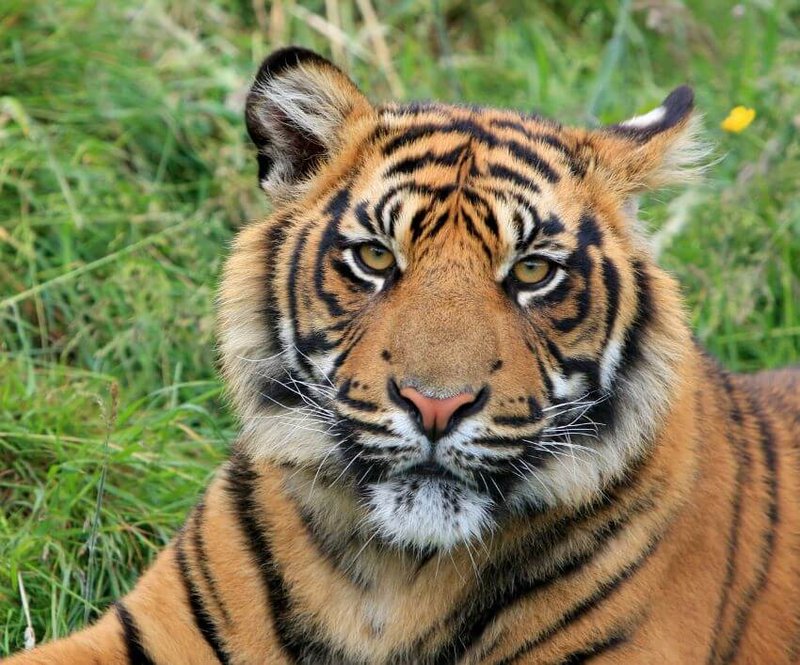
Now, let’s take a closer look at what’s happening with these magnificent animals, how they’re doing in the wild, and what efforts are underway to ensure their survival. Imagine you’re sipping a latte with me, and we’re diving deep into the world of conservation—ready?
Understanding the Sumatran Tiger
The Sumatran tiger (*Panthera tigris sumatrae*) is one of the smallest tiger subspecies, and it boasts a distinctive appearance. Characterized by its dark orange coat adorned with thick black stripes, it’s built for stealth. Think of it like a sleek sports car through the dense forests of Sumatra, perfectly adapted for hunting its natural prey such as deer and wild boar.
Unlike its relatives in other parts of Asia, the Sumatran tiger has a few unique traits. For instance, its smaller size helps it navigate the island’s rugged terrain more easily. You might picture it quietly stalking through the underbrush, using its incredible sense of hearing and sight to locate prey. Sadly, it’s this very habitat that is shrinking rapidly due to human activity.
The Endangered Status of the Sumatran Tiger
The Sumatran tiger is classified as Critically Endangered by the International Union for Conservation of Nature (IUCN). This classification means that the chances of these tigers becoming extinct in the wild are alarmingly high if action isn’t taken. Picture a ticking clock—time is running out for these magnificent animals.
Several factors contribute to this dire situation:
- Habitat loss: Deforestation for palm oil plantations, logging, and agriculture destroys their homes.
- Poaching: These tigers are hunted for their beautiful fur and body parts which are used in traditional medicine.
- Decreasing prey base: As their natural prey becomes scarce due to poaching and habitat destruction, tigers struggle to survive.
With such threats looming, you might be wondering what the future holds for the Sumatran tiger.
Current Population Estimates
Estimates suggest that there are only around 400 to 500 Sumatran tigers left in the wild. That’s a small number when you consider the vastness of their habitat on Sumatra. To visualize this, imagine cramming an entire basketball team into a small room. That’s just how few of them remain, which makes their conservation all the more critical.
This dwindling population is a wake-up call. When you look at the numbers, it’s not just about saving a single species; it’s about preserving the entire ecosystem that depends on these tigers. They play a key role in keeping prey populations in check, helping maintain a balance within their environment.
Global Conservation Efforts
So, what’s being done to help the Sumatran tiger? Various organizations and governments are stepping up to protect these magnificent creatures. Conservation efforts include:
- Protected Areas: Creating and maintaining national parks and reserves where tigers can thrive without the threat of human interference.
- Anti-Poaching Initiatives: Training rangers and employing surveillance technology to deter poachers and protect the tigers from illegal hunting.
- Community Engagement: Involving local communities in conservation efforts, offering education on sustainable practices, and alternatives to poaching.
Here’s the thing: effective conservation requires teamwork. It’s not just about protecting tigers, but also the environment they live in and the people who share that space. In many cases, working together can lead to benefits for both wildlife and local communities.
Success Stories and Challenges
There have been some heartening success stories in tiger conservation. For example, initiatives in Sumatra have led to the establishment of protected parks where tigers are monitored and protected. However, these wins don’t come without their challenges.
Despite progress, poaching still poses a significant threat. Even with increased patrols in protected areas, some criminals manage to slip through the cracks. It’s like trying to seal a leaking balloon—every time one hole gets patched, another pops up.
In addition to poaching, climate change is becoming an increasingly pressing issue. As temperatures rise and weather patterns change, the forests that tigers rely on could become uninhabitable. This is a problem that’s not going away anytime soon, and it’ll take a concerted global effort to mitigate these impacts.
What You Can Do to Help
So, how can you play a part in saving the Sumatran tiger? Believe it or not, your actions can have a ripple effect across the globe. Here’s how:
- Support Conservation Organizations: Consider donating to wildlife conservation groups that are actively protecting the Sumatran tiger.
- Raise Awareness: Share information about the Sumatran tiger and its plight on social media to spread the word.
- Choose Sustainable Products: Opt for products that are eco-friendly and don’t contribute to deforestation, especially palm oil products.
Just being more mindful can make a difference. It’s like throwing a stone into a still pond—the ripples of your actions can create waves of change.
The Future of the Sumatran Tiger
The future of the Sumatran tiger hangs in the balance, but there’s still hope. Conservation programs are evolving, and awareness around the importance of biodiversity is growing. With more people getting involved, there’s a chance these incredible cats can continue to roam the forests of Sumatra.
In the end, protecting the Sumatran tiger isn’t just about saving a species; it’s about maintaining the health of our planet. Each tiger represents a piece of our natural heritage. Losing them would be like losing a star from the night sky—irreplaceable and dearly missed.
The journey ahead may be challenging, but if we work together, we can ensure that future generations will still hear the roar of the Sumatran tiger echoing through the jungles. Let’s keep that dream alive!

